When I first walked past Glyph Café & Art Space, which was one evening after The Big Legrowlski by the Pearl/North Park Blocks, I thought it was, at first glance, an art gallery. The space inside just looked so carefully crafted artistically and well, so tasteful with a mix of open space and interesting art pieces.
Then I realized how many tables and chairs there were, even though quite a few of the tables actually looked like they were showcasing art themselves since they were shadowboxes. I then assumed it was an artsy coffee and tea cafe.
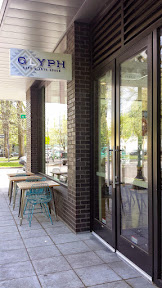



Well, then Irene Squizzato (of Watershed Communications – my first visit was a complimentary meal though I have since visited again on my own dime) invited me to try Glyph for lunch. And, so the answer turns out to be even better. So much better that I believe that Glyph Cafe is totally a secret hidden gem right now, it’s totally being under-appreciated and under-rated because of that, and I am excited to spill the beans and share it with you.
First of all, there is no denying the space is beautiful. It is full of light, but also lots of little details that make it feel lovely and loved. Little things like the tiny but incredibly arranged small flowers around the room. The one solid wall in Glyph has art that rotates out to showcase a new artist. The light fixtures of wood that dangle by the window on the other long wall another one of many details that bridge the airy high ceilings with the occupied space below. There are the odd shaped tables that are easily re-arranged as needed for groups, the different shapes of round chairs and triangle chairs and metal stools that are all functional and even comfortable but also are fun for the eye – they are all part of the variety of textures and shapes and colors that make the space of Glyph itself art.


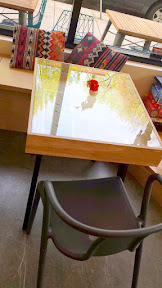
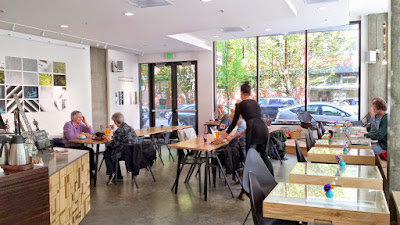
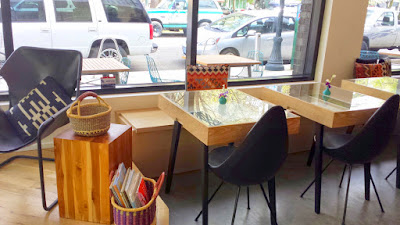
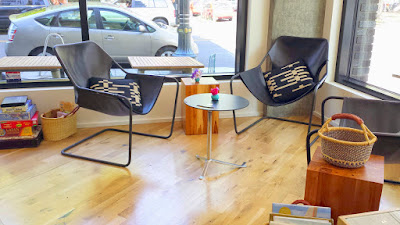

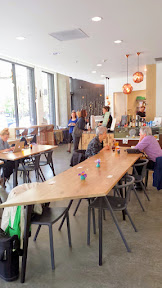

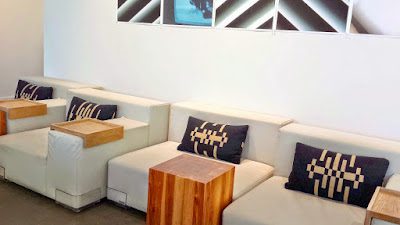
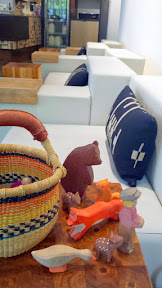
When you first enter you will see what I thought was a Wish Wall, but which owner Sandra Comstock officially has named the Poetry Wall. Evoking a Portland version of the Western Wall, you can see folded notes of hopes and wishes tucked into the wooden wall. But, that’s only a physical manifestation of the sanctuary feel of Glyph and the community of people it represents.


As Sarah explains, “Our poetry wall was inspired by a story I happened to hear on NPR (on the Wailing Wall) as we were developing our plans for Glyph. It seemed to me initially that it would be lovely to have a wall where people could exchange poetry, haiku or what have you. But over the last year people have made it their own – some place notes of gratitude – even some to us. Others draw cartoons with funny captions – my daughter has an ongoing character called fake fang girl who is pictured doing different dastardly deeds. ”
“Some of our baristas have started very funny stories or collaborated – one drawing a picture with the other inventing the caption. In other cases people have written out laments, jokes, or longings. I now often think of it as a sort of our crowd-sourced, interactive fortune cookie – like fortune cookie fortunes – it is a mystery what words of wisdom or silliness or seriousness one might receive. I always encourage people to take or leave as many as they like.”
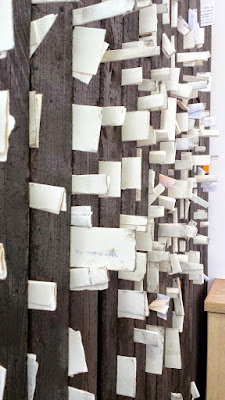
“Design wise – the wall is made of charred cedar planks and niches built by Reed La Plant – an exceptionally talented and kind architect turned furniture makers. In the niches are a series of en-caustics created by my friend Rio Wren – she goes through abandoned industrial buildings collecting old nails, gears, – the detritus of industrial society – and then rusts them on to silk and finally coats them with wax. I asked Rio to make what I refer to as “post-industrial glyphs” for our wall – that is images that reference glyphs found in the caves and walls around the world made by earlier civilizations – but produced from shapes and items left over from the height of 20th century factory life in the US. In any case – I get great satisfaction from looking at the wall and watching people interact with it … I also have some really nice pictures of that interaction which i will include.”

The seating at the counters and tables and couches do a wonderful balance of allowing personal space for your choice of deep or light hearted conversation while also being comfortable and plentiful enough to easily find a seat. At the same time, there is a communal feel in everyone sharing this open space and those little flowers (which by the way, are fresh from the garden daily).
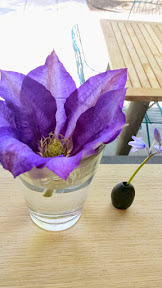

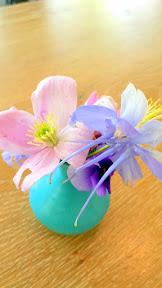
Restrooms at Glyph Café & Art Space are through a hallway marked by a restroom sign which is the nicest sign I’ve ever seen. Through the hallway is where you then have to use a key (attached to a paintbrush of course as a whimsical artistic nod) to get into the individual restroom
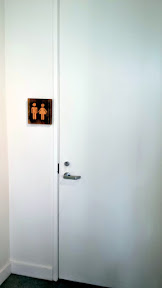


Second of all, Glyph also boasts an amazing chef who truly has a local, seasonal, farm to table and sustainable vision. Chef Doug Weiler literally goes to Portland Farmers Market on Saturday with his sous chef with no preconceptions in mind, sees what is fresh, and starts to make up the menu from there. The menu is written in chalk, and is carefully curated to only a handful of items, literally – only 4-7 options of plates (separate from pastries and beverages like coffee, tea, wine, cider, and beer of course). Doug also embraces a philosophy of rising to the challenge of trying to use the whole ingredient, with little to no waste.

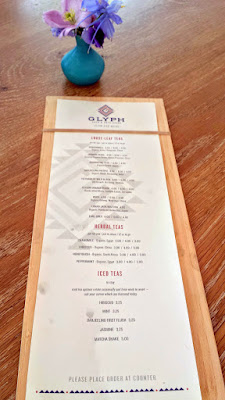
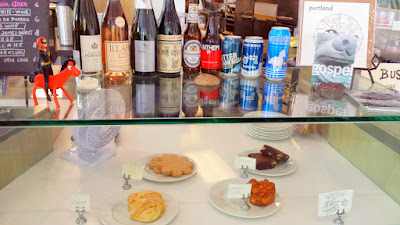
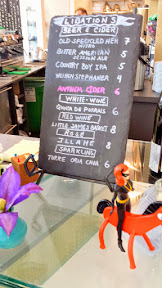
At a lunch I shared with Irene Squizzato and Emily Katz (whose design taste makes me wish she could decorate my entire house and maybe life), I got a taste of some of this sustainable and whole method for food in dishes like their featured Whole Vegetable Special, which is intended to be a regular feature with the Glypp menu.
When we visited, we tried the Heirloom Carrot version of the Whole Vegetable Special of Carrots that included Heirloom Carrots in a carrot emulsion, carrot top pesto, salted green garlic and toasted farro.


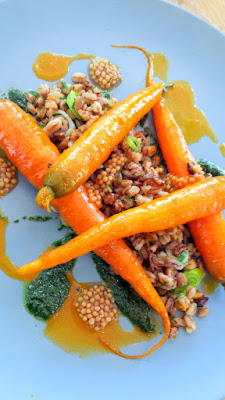
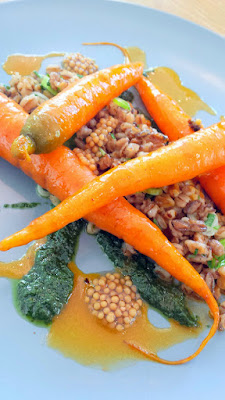
Other Whole Vegetable Dishes in the past include Beet Green Yorkshire Pudding with Salted Greens and Raw Shaved Marinated Beets, Pasta with Market Greens and Preserved Stems, and Mushroom and Trevisio Toast with Poached Egg Yolk (the toast had roasted mushrooms, and a mousse was made from the stems that would otherwise be too woody to eat on their own).
Another recent special from Chef Doug was called Rice and Herbs where a risotto cooked with an herb stock made from the stems of herbs picked for an herb puree to finish the risotto and the herb salad that would also garnish the risotto. The dish is further garnished with shaved raw sunchoke, and a house-made rice milk drizzled over the top and then finished with a sprinkle of bee pollen and olive oil. Chef Doug proudly stated that “From start to finish, this dish was made with nothing being thrown away.”
“If we can’t utilize the entire product in one dish, we will do our best to preserve it in some way to utilize in another dish in the future. This is done by pickling, dehydrating, making into a jam… The goal is to eventually have 100 percent utilization of all product brought into the cafe. As the summer approaches, there will definitely be some really exciting Whole Ingredient dishes being featured. The goal is to keep them vegetarian, or as close to it as possible.”

Chef Doug, similar to owner Sandra and her eye for detail in terms of decor and art, also has lots of details down in terms of execution technique and balance for those dishes. There may only be a few options on the menu, but every dish option is carefully constructed and crafted.
For instance, another special dish at Glyph I tried during my visit was Asparagus, Collard Rabe with Beeswax potatoes and Bee Pollen and Whipped Egg Yolk. This dish really helps illustrate the detailed thoughts Chef Doug uses to create a dish. He explained that in conceiving this dish, he referenced Caneles de Bourdeau, one of his favorite pastries because of it’s crunchy outside and creamy custardy inside but that is difficult to master because the Canele needs to be coated in beeswax before baking. His research also brought him to influences around the world, such as Chef Heinz Reitbauer of Restaurant Steirereck in Vienna, Austria who has been using molten beeswax to cook fish.
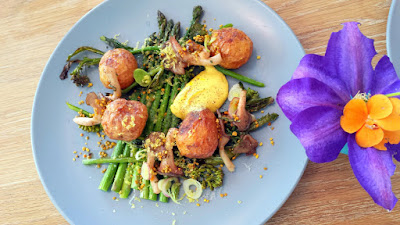
Chef Doug explained that in formulating this dish “When I was at the market last Saturday I came across two women selling honey, bee pollen, and beeswax. My mind was immediately filled with ideas about how I can best utilize this beautiful product with the spring ingredients that were available. I wanted to experiment with cooking potatoes in the beeswax. It took a bit of trial and error, but I finally figured out a method that creates a crispy golden brown skin of the potato with a creamy center that has a very subtle honey flavor.”
“I have always been a fan of the floral quality that honey adds to things, and have always used honey as a way to being out more flavor in vegetables such as asparagus and bitter greens such as rabe. I figured that the wax would provide the same balance. The bee pollen sprinkled on the plate was more to bring out the honey flavor in the potato than anything else.”
“The last component of the plate was whipped egg yolk. This was my way of not simply serving asparagus with Hollandaise or a poached egg. The yolks were infused with rosemary for two days, and then cooked at 62.5 C for 6 hours. Once cooled they can be whipped either by hand or in a Kitchenaid. The result is a beautiful rich airy egg mixture that I hoped would tie all the ingredients on the plate together, while adding some sort of fat to the dish. That is really the story of how this plate came to be. It is a simple plate of food, but something that i have been developing in my mind for quite a few months now.”

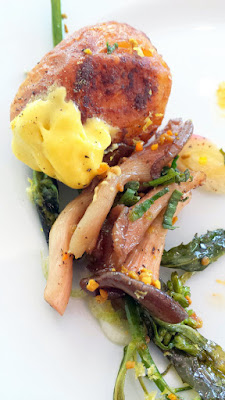
For a simpler example (because despite what Chef Doug said, I wouldn’t call that Aspragus and Beeswax Potatoes dish simple…), see below. Despite the brownness of the plate, what you’re looking at below is a dish of Warm Pork Rillette with oat crust, some slices of citrus, pickled shallot, and Fressen seeded rye bread slightly warmed/toasted. (loooove Fressen Bakery, the bread is so seedy and German!). The dish was a wonderful balance of textures and flavors and even hot and cold, from the soft rillette that was warm and savory to the seedy yet sweet of the bread and punches of acid in two different ways from the cooler citrus and the pickled shallot. This dish is available both at breakfast and lunch.
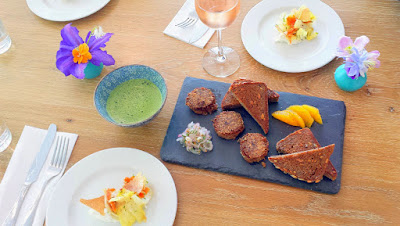

This is just my individual portion of the Salmon and Endive Salad that includes smoked Coho salmon, belgian endive, oregon hazelnuts, herbs, potato, and goat cheese (there has also been a version sometimes that uses housemade ricotta), but it too, was a balance of textures and flavors. I also enjoyed the bowl presentation of the Liquid Jade/Matcha, an organic powdered green tea from Japan.
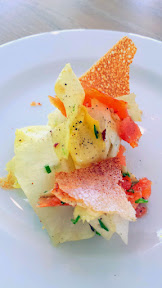


Meanwhile, the latest pasta dish (there is always one on the menu) when I visited was a Torchio Pasta dish with market greens, oyster mushrooms, parmesan, cured egg yolk, whipped egg yolk, and preserved tatsoi stem. After mixing it all together, it was as warm and comforting as mac and cheese but with a lot more depth of flavor. The oyster mushrooms had literally come into the kitchen that day. I loved what the tatsoi was like here wilted as well, and now I know to look beyond wilting just regular old spinach, kale, and arugula into my pastas.
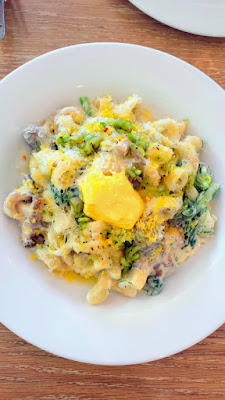
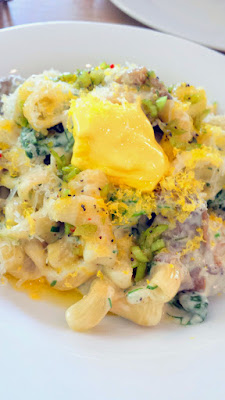
For something on the non vegetarian entree side, there is always a chicken entree, such as this Chicken leg confit with chicken breast roulade over cracked rye porridge, sunchokes, potatoes, green garlic, and chicken jus teased me all day when I took the leftovers after lunch to work, tempting me with how incredible it smelled even in the box.
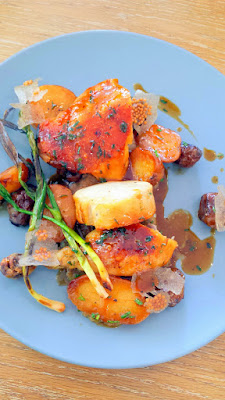

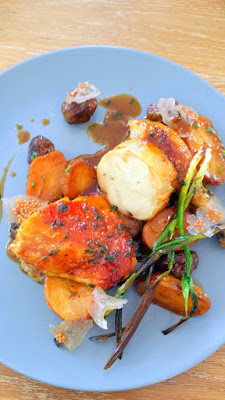
As a third point, Glyph also functions as an event space. A small stage that usually houses a couple comfy chairs for perhaps reading with coffee and tea also serves as a location for poetry readings and live music, and event and community space.
Don’t be surprised to see lots of cool artsy people here: the location of Glyph also happens to be the first floor of the Pacific Northwest College of Arts (PNCA) ArtHouse dorm. That will also explain why you might see a lot of laptops with people working on it- but rest assured, Glyph is indeed open for the public. Although they are open mainly for breakfast and some lunch and mid-day bites/drinks (they close at 6 on weekdays and 5 on Sat, closed completely Sunday), they are also part of First Thursday every month in the Pearl and other special events as they come up.


Now the only question is, which of these seating areas best suits you?
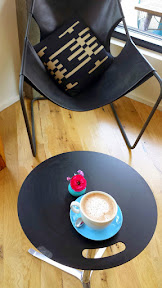
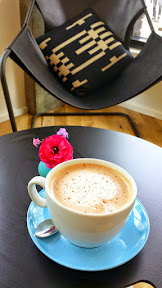

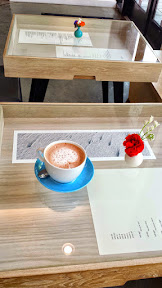
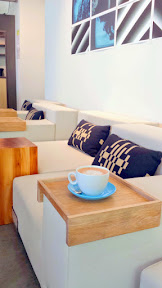
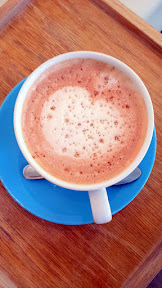
I hope this post has gotten you intrigued about this little hidden gem in the Pearl/North Park Blocks. Have you heard of it before, what are you thoughts of my little visual tour? Did any of these dishes, whether vegetarian or not, interest you? Would you contribute to that Poetry Wall?
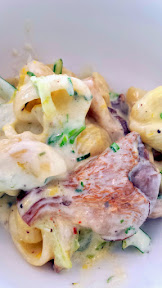
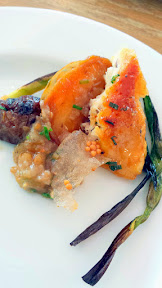
Disclosure: My first meal was complimentary, but I visited again on my own dime. I will always provide my honest opinion and assessment of all products and experiences I may be given. The views and opinions expressed in this blog are entirely my own.







